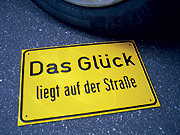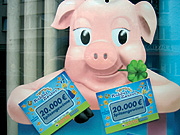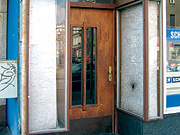
Andrea Knobloch developed the following idea 'The Luck is in the Streets (II)". Due to budgetary constraints, as well as structural and conceptual considerations, it will not be realised. Instead she has developed a new idea, titled "stadtraum.org.mobil: touring the city". This is in collaboration with Markus Ambach, under the label stadtraum.org.
 Andrea Knobloch (born in 1961) lives in Düsseldorf |
"The Luck is in the Streets (II)" Situation The green space we understand as "free space" - for mankind and for vegetation - does not exist in cities. Instead, urban nature is predominantly domesticated and functionalised. Plants and foliage are selected in regard to safety and defence, or for their suitability to the decorative surface. Options for usage are quite restricted in these spaces: many things are forbidden. In the few playgrounds that there are, stereotyped playground toys are set up to be played with, but these subjugate the user to the formal structures of established action models. Despite this, green spaces still function as the main areas for urban socialising. Relaxation and leisure, confrontation with unexpected communication, time to watch others or to concentrate on oneself: these elements are able to transport the idea of "public" life into the urban reality. Green spaces provide opportunities for free interchange by producing different codes and meanings that give them the opportunity to take on further levels of meaning. 'The Luck is in the Streets (II)' infiltrates existing regulations of green spaces by employing tactics of unnoticeable change. In this way, customary usage is subtly modified and concentrated. The White Dutch Clover (Trifolium repens L.) belongs to the pea family. It grows in meadows and pastures, as well as in park lawns and fields. It is a hardy plant that thrives in pruned and trodden areas. Its roots grow to a length of up to 1m into the ground, so that it can easily withstand dry seasons. The White Dutch Clover is a perennial creeper with a root-driving stem, which holds three leaves with a white mark on their topside. Some parts of the plant are said to have healing powers and its florets give delicious honey. Since it collects nitrogen, it also has a lasting improving effect on the soil. The White Dutch Clover also has one peculiarity which makes it ideal for the project: Its leaves are prone to abnormality. While developing over a "normal" course only three leaves are produced on its stem, a variation of four leaves occurs in a ratio of 0.1 to 100. And in many cultures, the finding of a four-leaf clover is regarded as a sign of good luck. 'Okkupation' In spring 2005 (sowing period: April-May) the clover population in Neukölln will be increased with the help of collaborative partners in the district - preferably youth clubs, and in particular the ones which concentrate on working with young girls. Plenty of seeds will be distributed in certain parts of green spaces. Without provoking objections which can be raised by more intrusive visibility, the Dutch White Clover will be able to grow undisturbed until summer. The communication of a related story is as important an element to the project as the long term "manipulation" of the frequency in occurrence of "lucky clovers" in Neukölln. A short text on the ongoing manipulation of the clover population in Neukölln and the related story about four leaf clover are attributed good luck bringing powers is produced. For the opening of "Okkupation" the text will be published in all daily and weekly newspapers in the area; in neighbourhood information points as well as in communal and club papers in all represented languages of the area. Theoretically, anyone passing through the area could stumble on this information and find a lucky clover. In order to be able to find the clover, an increased attention to the city space is necessary. Collected copies of the published press coverage of the project will form the visible contribution of 'The Luck is in the Streets (II)' during 'Okkupation'. This will be exhibited at suitable sites in the district, for example vacant vitrines or shop windows. Through a website (set up for the duration of a year) it will be possible to contribute responses to the findings and the resultant lucky events. |
|
| Website: www.stadtraumorg.de |

|

|
|
|
Grünfläche an der Karl-Marx-Straße |
"Stadtgrün" im Ostbahnhof |
|

|

|
|
|
Dekorativer Pflanzenschmuck (Richardstraße) |
Spielplatz in der Gropiusstadt |
|

|

|
|
|
Weißklee |
Geschenktes Glück |
|

|

|
|
| Glück zum kaufen | Vitrine an der Karl-Marx-Straße |